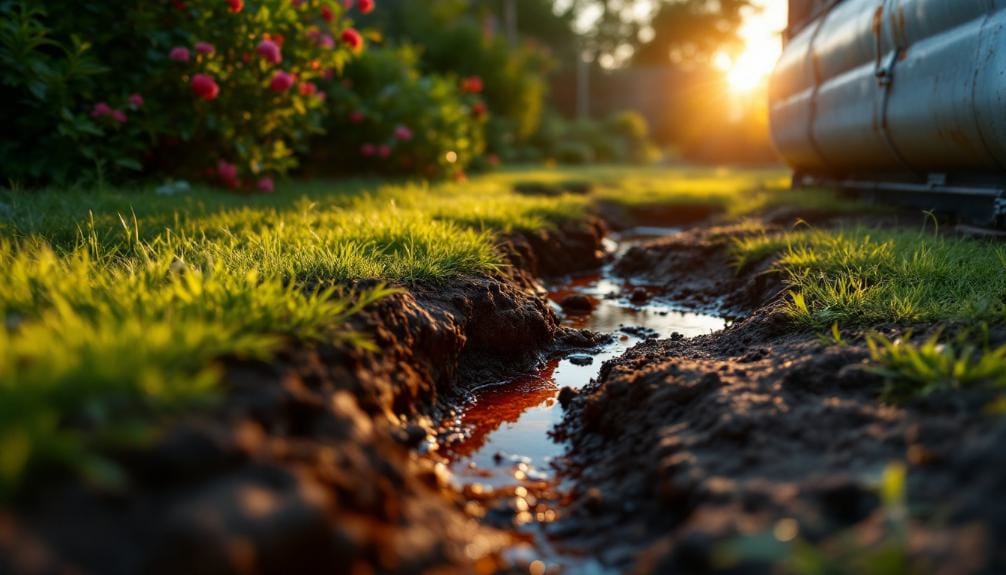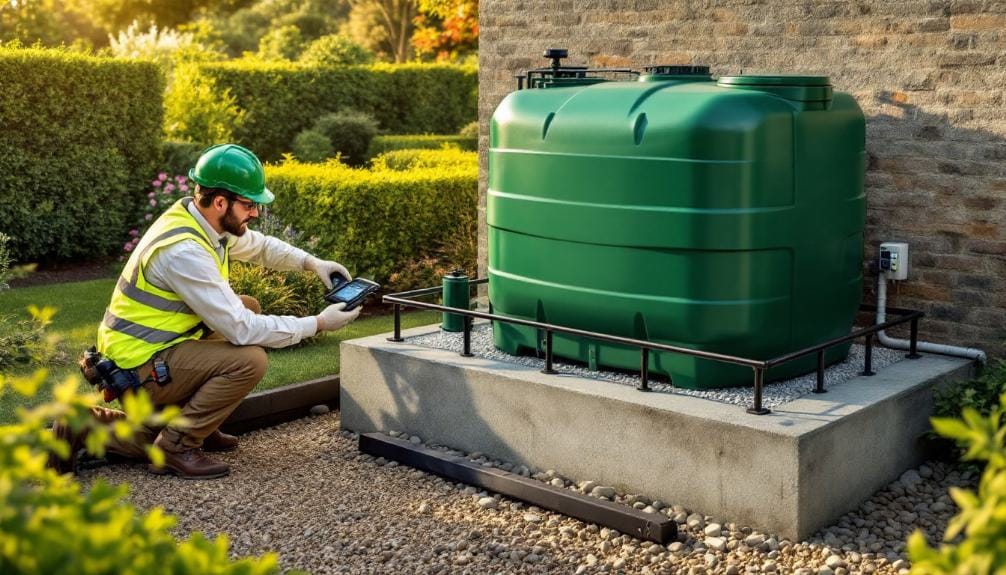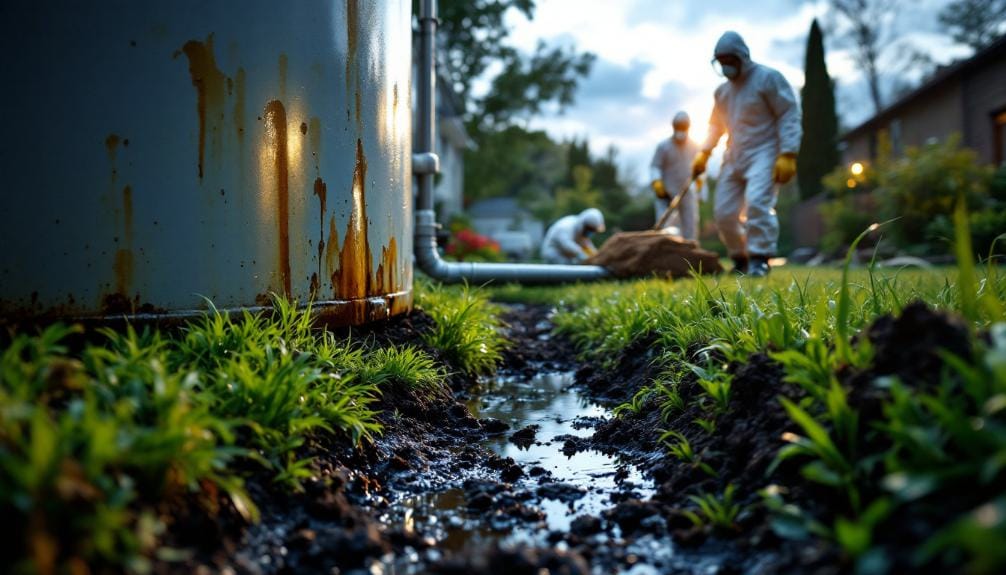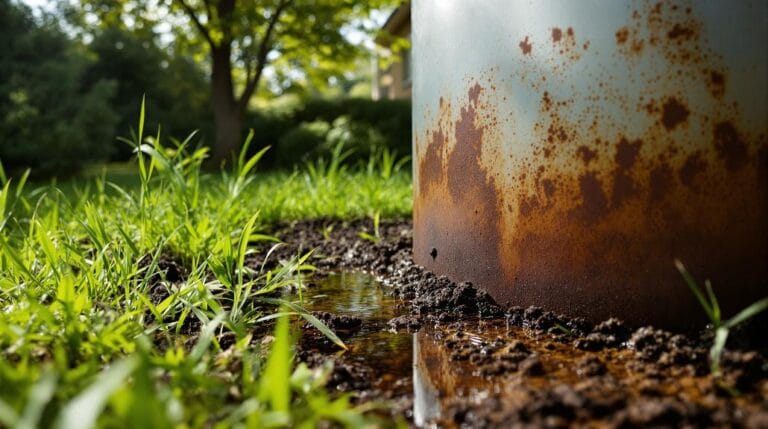Garden oil tank leaks can be a major concern for UK homeowners, leading to environmental damage and costly repairs. Understanding how to handle insurance claims is crucial in these situations. This guide breaks down the steps you need to take when dealing with oil leaks and filing a successful insurance claim.
Key Takeaways
- Most UK home insurance policies cover sudden and accidental oil spills but exclude gradual leaks resulting from poor maintenance.
- Document the leak immediately with photographs and notes, then contact your insurer before commencing any major cleanup work.
- The costs of cleanup typically range from £8,000 to £80,000, with severe contamination cases potentially exceeding £400,000.
- Insurance claims require evidence of regular tank maintenance, and tanks over 15 years old may face coverage limitations.
- Take immediate action by stopping the oil flow, containing the spill with absorbent materials, and preventing its spread to soil or water.
What should I do if I discover an oil tank leak in my garden?

Discovering an oil tank leak in your garden requires fast action.
Immediate steps to take when you spot an oil leak
When an oil tank leak occurs in your garden, three crucial actions must be taken immediately to minimise environmental harm and protect your property.
Firstly, cease using your oil heating system and identify the source of the leak. Similar to stopping a running tap before mopping up water, this prevents the situation from deteriorating further.
Next contact a Loss Assessor and ask for oil spill remediation advice. They will guide you through the cleanup process and the claims process.
These experts will evaluate the extent of property damage and implement containment measures to prevent the leak from spreading to neighbouring properties or water sources. Think of them as environmental primary responders – they know precisely how to handle the crisis. They should also document everything for you by taking clear photos of the affected area and keeping records of all communications.
How to assess the extent of the oil spill or leak
To properly assess the severity of an oil spill, one must engage in meticulous observation and systematic documentation. When evaluating the extent of an oil leak, commence by safely examining the visible spread of oil on the ground and any staining patterns. Capture photographs from multiple angles and jot down detailed notes regarding the size and appearance of the affected area.
Bear in mind that what is visible on the surface may only represent a fraction of the issue—an oil leak can lead to significant underground contamination that is not immediately evident. Consider it akin to an iceberg, where the visible portion suggests a larger issue beneath. To bolster your insurance claim, measure and map the affected area using reference points in your garden, such as trees or pathways.
Pay particular attention to signs that might indicate the severity of the damage, such as dead vegetation, strong odours, or oil sheen on standing water. Document any damage to the property, including stained concrete, affected landscaping, or compromised structures.
It is also advisable to note weather conditions and dates, as these details can assist experts in determining the duration of the leak and its potential spread pattern.
When to contact your insurance company about the leak
Upon discovering an oil tank leak in your garden, it’s important to contact a Loss Assessor first, before contacting your insurance company—do not delay! Your Loss Assessor will be able to conduct a full independent assessment on your behalf. Similar to finding a burst pipe, quick action can significantly minimise damage and safeguard the validity of your claim.
The Loss Assessor will contact the insurance company on your behalf and will guide you through the claims process. Consider them as a trusted partner on your side—they have dealt with numerous similar situations and are well-versed in the necessary steps to take.
When you make the call, be ready to provide basic details about the oil leak or spill. Don’t worry if you do not have all the information yet—your initial call is about getting an expert on your side.
Your insurer will likely engage a Loss Adjuster to evaluate the extent of the contamination and negotiate a settlement, so it’s advisable to have your own independent professional to negotiate on your behalf.
Does my home insurance cover oil tank leaks and spills?
Home insurance coverage for oil tank leaks can be as tricky to navigate as a maze in the dark, with policies varying markedly between insurers and regions.
Most standard home insurance policies provide some cover for sudden and accidental oil spills, but they often exclude gradual leaks or environmental contamination that occurs over time.
Understanding your specific policy’s terms, including cover limits and exclusions for oil-related incidents, is essential before an emergency arises, as cleanup costs can quickly escalate into thousands of pounds. This is where your Loss Assessor becomes a valuable ally. They will know exactly what your policy entitles you to and how to negotiate a fair settlement that gets you everything you’re entitled to.
Understanding your home insurance policies regarding oil damage
Understanding whether your home insurance policy covers oil tank leaks necessitates a careful review of your specific coverage terms, as many standard homeowner policies either exclude or strictly limit oil damage claims.
It’s akin to reading the small print on your mobile phone contract – what appears straightforward often isn’t.
When reviewing your home insurance policies, look specifically for terms related to “escape of oil” or “oil damage” coverage. Some policies provide comprehensive protection, while others may only cover certain scenarios.
Think of it as a safety net – you need to know exactly how strong that net is before you need it.
Your insurance coverage might include cleanup costs, property damage, and even environmental remediation, but limitations and exclusions often apply.
The key is understanding what your insurance policy provides before an incident occurs.
Consider scheduling a discussion with your insurance provider to clarify any grey areas – it’s better to ask questions now than face surprises later.
Remember to keep documentation of all maintenance and inspections, as insurers often require proof that you’ve properly maintained your oil tank to validate any future claims.
Types of oil-related incidents typically covered by insurers
Insurance providers typically recognise several distinct categories of oil-related incidents when determining coverage for residential properties. Most standard home insurance cover includes sudden and accidental oil spills from domestic heating systems, especially when the damage caused affects your property or neighbouring land.
Consider it a safety net for those “oops” moments that can happen to any homeowner.
Common scenarios that insurance policies generally protect against include heating oil leaks from burst pipes or faulty tank connections, accidental overfilling during delivery, and damage to the tank from falling objects or extreme weather.
Just as you’d expect your insurance to assist if a pipe bursts inside your home, these outdoor oil-related accidents usually fall under similar protection.
However, it’s worth noting that gradual leaks or damage resulting from poor maintenance typically won’t be covered.
Insurance companies expect us to be responsible homeowners, much like how we maintain our cars to keep them running safely.
That’s why regular tank inspections and proper maintenance aren’t just good practice—they’re essential for keeping your coverage valid.
Exclusions and limitations in oil damage insurance claims
Several critical exclusions exist in oil damage insurance policies that homeowners must be aware of before assuming they’re fully protected.
Whilst many policies cover accidental oil leaks, insurance may not extend to certain situations that could leave you financially exposed. Understanding these limitations upfront can help prevent unpleasant surprises during the claims process.
Common exclusions that affect home insurance claims include:
- Gradual deterioration or wear and tear of oil tanks, especially those over 15 years old
- Damage resulting from poor maintenance or failure to conduct regular inspections
- Environmental cleanup costs exceeding standard policy limits, which can be substantial
It’s worth noting that most policies cover sudden and accidental spills, but they won’t assist if you’ve neglected your responsibilities as a tank owner.
Think of it like maintaining your car – you can’t expect your insurance to cover engine failure if you’ve never changed the oil!
Furthermore, some insurers require specific tank standards and certificates before they’ll provide cover.
When in doubt, review your policy details carefully and consider further environmental liability cover to fill any gaps in your protection.
How do I make an insurance claim for an oil tank leak?

Making an insurance claim for an oil tank leak requires following a clear set of steps to ensure the best possible outcome.
When homeowners discover an oil leak, prompt action and proper documentation become essential components of a successful claims process.
Understanding how to navigate the claims path, from initial notification to final settlement, can help reduce stress and improve your chances of coverage.
Step-by-step guide to the oil damage claim process
Filing a claim for an oil tank leak involves four essential initial steps to safeguard your interests and comply with insurance requirements. When you discover an oil leak or spill, prompt action can greatly influence the smooth progression of your property damage claim.
- The first step (and the one that removes the hassle for you) is to appoint a Loss Assessor.
- They will document everything for you, including photographs and detailed notes about when and how you identified the leak.
- They will contact your insurance company to report the incident, obtain a claim reference number, and handle any further communication and negotiate with the Loss Adjuster.
- You can take immediate action to prevent further oil damage, but refrain from starting any major clean-up until your loss assessor has assessed the situation.
Remember, we’re all in this together when it comes to handling these challenging situations. The success of your insurance claim often depends on following the correct procedures and maintaining clear communication with all involved parties.
Consider the process as constructing a careful record – each piece of documentation is another brick in the wall of your claim.
Your Loss Assessor will keep a dedicated folder for all correspondence, quotes, and invoices. Most insurance companies will assign a loss adjuster to evaluate the extent of damage, so remain patient. At PCLA we keep our clients up to date with any developments and you’ll have a dedicated point of contact who can answer all of your questions.
What are the potential consequences of an oil leak on my property?
Oil leaks from garden tanks can lead to severe and far-reaching consequences for property owners. Even a small leak can cause extensive damage to your property, potentially turning your peaceful garden into an environmental hazard zone.
The oil contamination often spreads far beyond the visible spill area, seeping into soil layers and potentially reaching groundwater.
Imagine oil pollution as an unwelcome houseguest that doesn’t know when to leave – it lingers in your soil and can render parts of your garden unusable for years. The impact extends beyond just unsightly stains; it can kill plants, harm wildlife, and create unpleasant odours that make outdoor spaces unbearable.
Additionally, neighbouring properties might be affected, leading to strained relationships and potential legal disputes.
The remediation process can be incredibly disruptive and expensive. You might need to excavate contaminated soil, replace garden features, and undergo lengthy environmental testing.
In severe cases, you could face prosecution from environmental agencies if the pollution affects local water sources.
The good news? Most of these headaches can be avoided through regular tank maintenance and early leak detection.
How can I prevent future oil tank leaks and spills?

A tank owner’s best defence against oil leaks lies in implementing a comprehensive prevention strategy. Regular maintenance of your oil tank and heating system isn’t just about protecting your investment – it’s about safeguarding your home and our shared environment.
Think of your storage tanks as the heart of your heating system; they need regular check-ups to stay healthy.
Here are three essential steps every responsible tank owner should follow:
- Schedule professional inspections of your oil tank at least once a year, looking for signs of wear, rust, or damage.
- Install an electronic oil level monitor to track usage and detect sudden changes that might indicate a leak.
- Ensure tanks or pipes are properly insulated and protected from weather damage, particularly during winter months.
Make it a habit to check your oil tank regularly, just like you would check your car’s oil.
Look for any signs of deterioration around seams and joints, and keep the area around your tank clear of vegetation and debris.
What if my insurance claim for oil damage is denied?
If your insurance claim is denied, you still have several options to address the costly expenses associated with oil spill cleanup. Contact PCLA today to find out what those options are in relation to your specific case.
How much does oil leak cleanup and remediation typically cost?

Call PCLA today to find out if you’re policy entitles you to FREE oil spill cleanup at your home.
Oil leak cleanup costs for residential tanks in the UK typically range from £8,000 to £80,000, though severe contamination cases can exceed £100,000. When addressing an oil leak, expenses often encompass soil testing, excavation, contaminated soil removal, and environmental consultancy fees.
Like many homeowners dealing with domestic oil spills, you’ll find these costs can rapidly accumulate.
Several factors influence the final cost. The extent of contamination, soil type, proximity to water sources, and accessibility to your property all play significant roles. It’s like treating a stain on your favourite carpet – the longer you wait, the deeper it sets and the more costly it becomes to rectify.
Having a Loss Assessor act on your behalf can be invaluable, as they’ll help manage the complex process of filing an oil damage insurance claim.
Beyond the cleanup costs, you’ll need to consider other expenses like replacing lost oil, temporary heating solutions, and restoring your garden.
Professional remediation companies typically charge by the hour, plus materials and equipment costs. Being prepared with adequate insurance coverage helps ensure these unforeseen expenses don’t deplete your savings.



